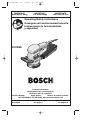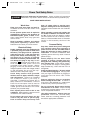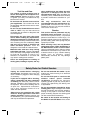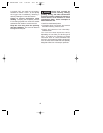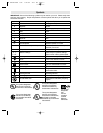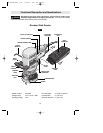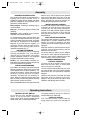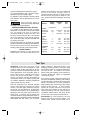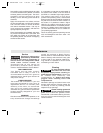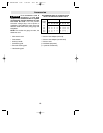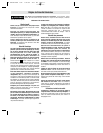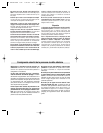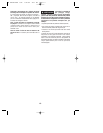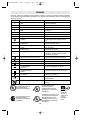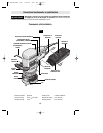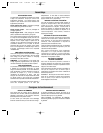
-7-
Assembly
BACKING PAD INSTALLATION
The random orbit sander is equipped with a
backing pad of soft hardness, which is
suitable for general service. Harder and softer
pads are available for other purposes, and in
general are used as follows;
Extra soft pad - Polishing or sanding large or
curved surfaces.
Soft pad - All purpose general sanding and
polishing.
Hard pad - Heavy sanding on flat surfaces,
especially with coarser abrasives.
To change backing pad, hold pad firmly and
turn screw counterclockwise with 5mm allen
wrench provided. Remove old pad, and place
new pad over locating pins on drive spindle.
Replace screw and securely tighten in a
clockwise direction with the allen wrench.
Damaged or worn backing pads must be
replaced immediately (Fig. 1).
BACKING PAD DAMPER
Your tool is equipped with an integrated
backing pad damper ring. This damper
reduces the no-load speed, which helps
prevent accidental marking of the workpiece
surface and provides uniform finishing.
NOTE: If you notice steadily increasing no-
load speed, this indicates that the damper ring
is worn and needs to be replaced.
INSTALLING ACCESSORIES
The random orbit sander uses hook-and-loop
backed accessories, which firmly grip the pad
when applied with moderate pressure. To
change the accessory, merely peel off the old
accessory, remove dust from the pad if
necessary, and press the new accessory in
place. Be sure to align the sanding disc holes
with the holes in the backing pad to allow the
dust extraction system to function.
After considerable service the pad surface will
become worn, and the pad must be replaced
when it no longer offers a firm grip. If you are
experiencing premature wearout of the pad
facing, decrease the amount of pressure you
are applying during operation of the tool.
INSTALLING DUST CANISTER
To attach dust canister, slide canister support
in direction of arrow (A) until it stops. Insert
mounting clip into the pocket provided on
canister. Then slide canister support through
mounting clip in direction of arrow (B) and
push onto the dust port. To remove, reverse
this procedure.
DUST COLLECTION CANISTER
The integral dust extraction system collects
sanding dust in canister supplied with your
sander. For maximum efficiency, the dust
canister should be emptied frequently during
operation.
When the canister is removed from the tool an
(optional vacuum hose accessory) can be
attached to the dust port.
To use this feature, attach vacuum adapter
and vacuum hose (optional accessories) to
dust port, then connect opposite end of the
vacuum hose to a shop vacuum cleaner.
CLEANING AND EMPTYING
THE DUST CANISTER
To empty, lift lid of canister. Knock excess
dust out of the micro filter, or remove dust
with your fingers or a soft brush.
You may notice that all the dust may not come
out of the canister. This will not affect sanding
performance but will reduce dust collection
efficiency.
NOTE: Do not wash the micro filter with soap
and water. Dust may become more firmly
lodged in the pores, which will reduce dust
collection, and damage the micro filter.
Operating Instructions
TRIGGER "ON-OFF" SWITCH
To turn the tool "ON" squeeze the trigger
switch. To turn the tool "OFF", release the
trigger switch, which is spring loaded and will
return to the "OFF" position automatically.
To increase switch life, do not turn switch on
and off while tool is under load.
"LOCK-ON" BUTTON
The "Lock-ON" button, located near the
trigger allows for continuous operation at
BM 2609932240 7/02 7/25/02 2:37 PM Page 7



